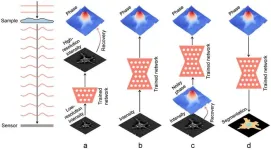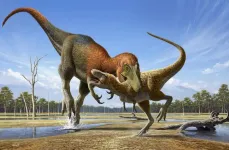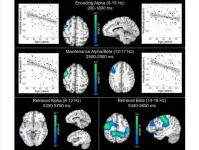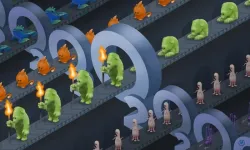(Press-News.org) Light, as an electromagnetic field, has two essential components: amplitude and phase. However, optical detectors, usually relying on photon-to-electron conversion (such as charge-coupled device sensors and the human eye), cannot capture the phase of the light field because of their limited sampling frequency. Fortunately, as the light field propagates, the phase delay also causes changes in the amplitude distribution; therefore, we can record the amplitude of the propagated light field and then calculate the corresponding phase, called phase recovery. Some common phase recovery methods include, holography/interferometry, Shack-Hartmann wavefront sensing, transport of intensity equation and optimization-based methods (phase retrieval). They have their own shortcomings in terms of spatio-temporal resolution, computational complexity, and application range. In recent years, as an important step towards true artificial intelligence (AI), deep learning, often implemented through deep neural networks, has achieved unprecedented performance in phase recovery.
In a new review paper published in Light Science & Application, scientists from The University of Hong Kong, Northwestern Polytechnical University, The Chinese University of Hong Kong, Guangdong University of Technology and Massachusetts Institute of Technology have reviewed various deep learning phase recovery methods from the following four perspectives:
• Deep-learning-pre-processing for phase recovery: the neural network performs some pre-processing on the intensity measurement before phase recovery, such as pixel super-resolution, noise reduction, hologram generation, and autofocusing.
• Deep-learning-in-processing for phase recovery: the neural network directly performs phase recovery or participates in the process of phase recovery together with the physical model or physics-based algorithm by supervised or unsupervised learning modes.
• Deep-learning-post-processing for phase recovery: the neural network performs post-processing after phase recovery, such as noise reduction, resolution enhancement, aberration correction, and phase unwrapping.
• Deep learning for phase processing: the neural network uses the recovered phase for specific applications, such as segmentation, classification, and imaging modal transformation.
To let readers learn more about phase recovery, they also presented a live-updating resource (https://github.com/kqwang/phase-recovery).
When deep learning is applied to various processes of phase recovery, it not only brings unprecedented effects but also introduces some unpredictable risks. Some methods may look the same, but there are differences that are difficult to detect. These scientists point out the differences and connections between some similar methods and gave suggestions on how to make the most of deep learning and physical models for phase recovery:
“It should be noted that the uPD (untrained physics-driven) scheme is free from numerous intensity images as a prerequisite, but requires numerous iterations for each inference; while the tPD (trained physics-driven) scheme completes the inference only passing through the trained neural network once, but requires a large number of intensity images for pretraining.”
“zf is a fixed vector, which means that the input of the neural network is independent of the sample, and therefore the neural network cannot be pre-trained like the PD approach.” they said when introducing the structural-prior network-in-physics strategy.
“Learning-based deep neural networks have enormous potential and efficiency, while conventional physics-based methods are more reliable. We thus encourage the incorporation of physical models with deep neural networks, especially for those well modeling from the real world, rather than letting the deep neural network perform all tasks as a black box.” the scientists suggest.
END
A University of Queensland-led study has found humans can tell if chickens are excited or displeased, just by the sound of their clucks.
Professor Joerg Henning from UQ’s School of Veterinary Science said researchers investigated whether humans could correctly identify the context of calls or clucking sounds made by domestic chickens, the most commonly farmed species in the world.
“In this study, we used recordings of chickens vocalising in all different scenarios from a previous experiment,” ...
A previously unidentified genetic mutation in a small protein provides significant protection against Parkinson’s disease and offers a new direction for exploring potential treatments, according to a new USC Leonard Davis School of Gerontology study.
The variant, located in a mitochondrial microprotein dubbed SHLP2, was found to be highly protective against Parkinson’s disease; individuals with this mutation are half as likely to develop the disease as those who do not carry it. The variant form of the protein is relatively rare and is found primarily in people of European descent.
The findings appear on January 3, 2024, in the journal Molecular Psychiatry.
First ...
Plastic litter is a growing problem around the world, and new research shows that the bottom of Lake Tahoe is no exception. In one of the first studies to utilize scuba divers to collect litter from a lakebed, 673 plastic items were counted from just a small fraction of the lake.
In the study, published in the November issue of the journal Applied Spectroscopy, researchers from DRI and the UC Davis Tahoe Environmental Research Center teamed up with the nonprofit Clean Up the Lake to take a close look at the litter. First, ...
Infants born extremely prematurely need to get enrichment as an addition to breast milk. But does it make any difference whether the enrichment is made from breast milk or cow’s milk when it comes to the risk of severe complications in children? This has been investigated by a large clinical study led from Linköping, Sweden.
Infants born extremely prematurely, between weeks 22 and 27 of pregnancy, are among the most vulnerable patients in healthcare. The risk of serious complications is very high. Almost one in four extremely premature babies die before the age of one.
There is strong research support for giving breast ...
A new analysis of fossils believed to be juveniles of T. rex now shows they were adults of a small tyrannosaur, with narrower jaws, longer legs, and bigger arms than T. rex. The species, Nanotyrannus lancensis, was first named decades ago but later reinterpreted as a young T. rex.
The first skull of Nanotyrannus was found in Montana in 1942, but for decades, paleontologists have gone back and forth on whether it was a separate species, or simply a juvenile of the much larger T. rex.
Dr Nick Longrich, from the Milner Centre for Evolution at the University ...
As the world moves away from gas towards electricity as a greener power source, the to-do list goes beyond cars. The vast global manufacturing network that makes everything from our batteries to our fertilizers needs to flip the switch, too.
A study from UChicago chemists found a way to use electricity to boost a type of chemical reaction often used in synthesizing new candidates for pharmaceutical drugs.
Published Jan. 2 in Nature Catalysis, the research is an advance in the field of electrochemistry and shows a path forward to designing ...
For people looking to start 2024 with a new routine to feel fitter and happier, a new study from the University of Bath suggests that combining mindfulness with exercise could be your key to success.
A study, published in the academic journal Mental Health and Physical Activity, suggests that life changes which combine both physical activity and mindfulness are most effective at lifting mood and improving health and wellbeing.
Both physical activity and mindfulness practice have well established psychological benefits. However, ...
A new artificial intelligence tool that interprets medical images with unprecedented clarity does so in a way that could allow time-strapped clinicians to dedicate their attention to critical aspects of disease diagnosis and image interpretation.
The tool, called iStar (Inferring Super-Resolution Tissue Architecture), was developed by researchers at the Perelman School of Medicine at the University of Pennsylvania, who believe they can help clinicians diagnose and better treat cancers that might otherwise go undetected. The imaging technique provides both highly detailed views of individual cells and a broader look of the ...
“[...] we discuss the implications of these novel findings on our understanding of how healthy aging affects verbal working memory processing.”
BUFFALO, NY- January 2, 2024 – A new research paper was published on the cover of Aging (listed by MEDLINE/PubMed as "Aging (Albany NY)" and "Aging-US" by Web of Science) Volume 15, Issue 24, entitled, “Age-related alterations in the oscillatory dynamics serving verbal working memory processing.”
Working memory (WM) is a foundational cognitive function involving the temporary storage of information. Unfortunately, WM ...
In the quest to understand the potential for life beyond Earth, researchers are widening their search to encompass not only biological markers, but also technological ones. While astrobiologists have long recognized the importance of oxygen for life as we know it, oxygen could also be a key to unlocking advanced technology on a planetary scale.
In a new study published in Nature Astronomy, Adam Frank, the Helen F. and Fred H. Gowen Professor of Physics and Astronomy at the University ...



